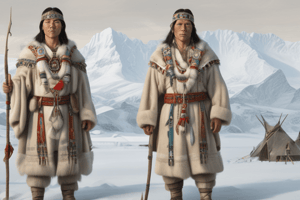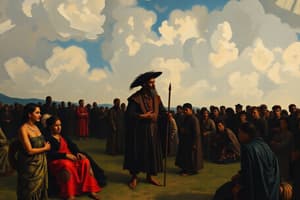Podcast
Questions and Answers
What was the main reason behind the formation of the Alliance System during World War I?
What was the main reason behind the formation of the Alliance System during World War I?
- To prevent the rise of communism
- To promote imperialism and colonialism
- To support the nationalist movements in Europe
- To maintain a balance of power among European nations (correct)
What was the primary cause of the Stock Market Crash of 1929?
What was the primary cause of the Stock Market Crash of 1929?
- The rise of communism in the United States
- The decline of the agriculture sector
- Overproduction and underconsumption
- Buying on margin and buying on credit (correct)
What was the main consequence of the Treaty of Versailles for Germany?
What was the main consequence of the Treaty of Versailles for Germany?
- It resulted in the formation of the League of Nations
- It led to the creation of the Treaty of Berlin
- It led to the rise of Nazi Germany (correct)
- It established the principle of self-determination
What was the main goal of the Canadian government's policy of assimilation towards Indigenous Canadians?
What was the main goal of the Canadian government's policy of assimilation towards Indigenous Canadians?
What was the primary goal of the Berlin Airlift during the Cold War?
What was the primary goal of the Berlin Airlift during the Cold War?
What was the main achievement of Tommy Douglas, a prominent Canadian politician?
What was the main achievement of Tommy Douglas, a prominent Canadian politician?
Flashcards are hidden until you start studying
Study Notes
Indigenous Canadians
- Residential Schools: forced assimilation of Indigenous children into European-Canadian culture
- Indian Act: legislation that governs the lives of Indigenous peoples, including land ownership and self-government
- Missing and Murdered Indigenous Women: a crisis of violence and disappearance affecting Indigenous women
- Treaties: agreements between the Crown and Indigenous peoples regarding land use and rights
- Colonization: the process of European settlement and displacement of Indigenous peoples
- 60s Scoop: a period of forced adoption of Indigenous children into non-Indigenous families
- Child Welfare System: a system that has historically prioritized removal of Indigenous children from their families
World War I
- Causes: militarism, alliance system, imperialism, and nationalism
- Battles: Vimy Ridge and Ypres
- Role of Women: increased participation in the workforce and war efforts
- Trench Warfare: a type of combat characterized by static trenches and heavy casualties
- Trench Foot: a condition caused by prolonged exposure to wet and unsanitary conditions
- Conditions: rats and other unsanitary conditions were prevalent in trenches
- Treaty of Versailles: the peace settlement that ended the war
The Roaring 1920s
- Flappers: young women who rejected traditional social norms and embraced new freedoms
- Inventions: insulin, telephone, radio, and automobile improved daily life and transformed industries
- Buying on Credit/Buying on Margin: financial practices that contributed to the Great Depression
- Person's Case: a landmark court case that established women as "persons" under Canadian law
The Great Depression
- Causes: stock market crash, buying on credit, overproduction, and overexpansion
- Bennett Buggies: makeshift cars built during the Great Depression
- Bennett Blankets: thin blankets distributed to relief camp workers
- Government Relief Payments: financial assistance provided to those in need
- Relief Camps: work camps for men who were struggling to find employment
- Business Cycle: recession, recovery, and growth phases
World War II
- Causes: appeasement, totalitarianism, fascism, communism, and economic problems
- Alliances: Allies (USA, UK, USSR) vs Axis (Germany, Italy, Japan)
- Battles: various battles fought on multiple fronts
- Role of Women: increased participation in the workforce and war efforts
- Japanese Canadian Internment: the forced relocation and detention of Japanese Canadians
- Holocaust: the systematic persecution and genocide of Jews and other minorities
- Stages: scapegoats, Kristallnacht, and concentration camps
- End of WWII: Europe, Japan, and the atomic bombings of Hiroshima and Nagasaki
- Cold War: the post-war ideological and political conflict between the USA and USSR
Post-War Canada and World
- Post-War Economic Boom: rapid economic growth and industrialization
- Factories, Jobs, and Car Industry: growth and development in manufacturing and industry
- Suburban Development: the growth of suburbs and urbanization
- United Nations: an international organization established to promote peace and cooperation
- Birth Control Pill: a revolutionary contraceptive that increased women's autonomy
- Viola Desmond: a civil rights activist who challenged racial segregation
- Canadian Civil Rights: the struggle for racial equality and human rights
- Overt and Covert Segregation: forms of racial segregation in Canada
- Health and Welfare after WW2: the establishment of Medicare and other social programs
- Tommy Douglas: a key figure in the establishment of universal healthcare in Canada
- Canada Pension Plan: a government-funded pension system for seniors
Power and Inequality
- Power: the ability to influence and control others
- Who benefits? Those who hold power and wealth
- Who doesn't? Those who are marginalized and oppressed
- Triangle: a model of power dynamics, with economic, political, and social power at the top
Studying That Suits You
Use AI to generate personalized quizzes and flashcards to suit your learning preferences.



